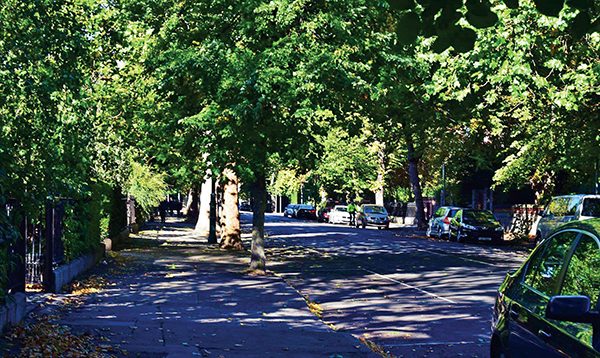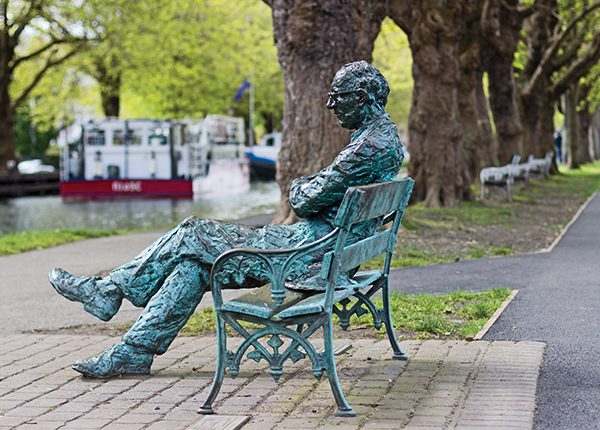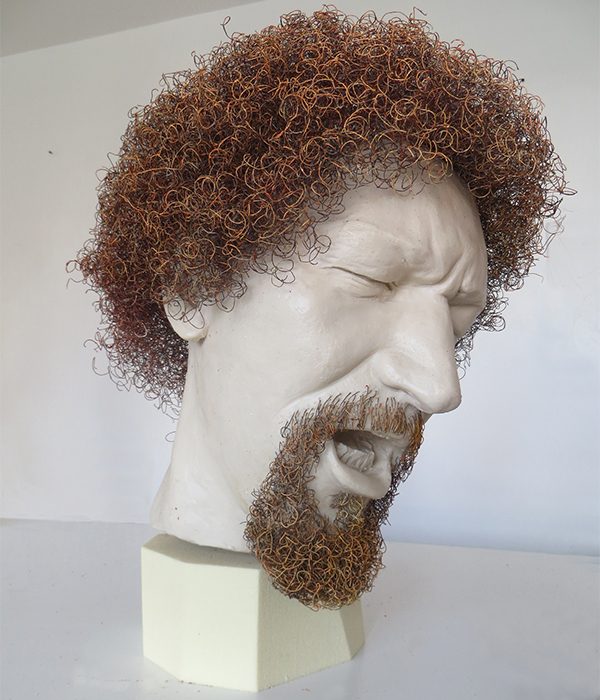
Pictured: A sunny day on Raglan Road. Photo: Kevin O’Gorman.
If and when I wander down peaceful Raglan Road, I can only imagine the beauty that struck Patrick Kavanagh’s eyes on that fateful day when they landed on Hilda Moriarty (reputed as being one of the two most beautiful women in Dublin at the time, the other being actress Kathleen Ryan).
With the road’s various trees of lime, flowering cherry and London plane lining the paths with their aged leaves, it’s no wonder Kavanagh described it as being the enchanted way, that we regard the road to be.
‘On Raglan Road’ is a famous ballad about unrequited love immortalized by the resounding voice of Luke Kelly. The words were originally written by Patrick Kavanagh, a Monaghan native, who became besotted with a woman, Hilda Moriarty. Although she was twenty years younger than he was, Kavanagh’s father also married his mother when there was also a similar age divide.
The poem was published under the title: ‘Dark Haired Miriam Ran Away’, in the Irish Press in 1946 and developed into a ballad in the ancestral air of ‘Dawning Of The Day’, which many people sang around Dublin. Miriam was the name of his brother’s girlfriend and according to his brother used the name “to conceal his embarrassment of being jilted.”
Kavanagh suffered from ill-health in the 50s and had a lung removed to fight cancer. A decade later at The Bailey in Dublin, he relayed the song to Luke Kelly in his emphysemic tone and Kelly gladly went on to give the ballad the legacy it deserved.

Pictured Above: Patrick Kavanagh on his bench by Peierls.
On Raglan Road is where Patrick met Hilda, probably while she was en route to UCD where she studied medicine. It’s not clear if Kavanagh moved into Mrs. Kenny’s ten shilling–a-week high-class lodging at no.19 Raglan Road after this or had been living there at the time. However, it’s rumoured he stayed in the top floor room with the low window that overlooks the junction at Elgin road.
They spent some time together and Moriarty enjoyed his poetry and conversation, although teased him about his poetry on agricultural matters (at that time Kavanagh was submitting poems to ‘The Farmers Journal’).
The following Christmas he invited himself down to Moriarty’s home in Kerry and it soon became obvious that her father did not see Kavanagh as a match for his treasured daughter. In a biography written by Antoinette Quinn that further illustrates their relationship, it recounts an autobiographical fable written by Kavanagh at the time titled: ‘The Lay of the Crooked Knight’, which sees a dishevelled knight with a ploughman’s gait whom his love attempts to gentrify by first stopping his drinking of whiskey and porter because it makes him too excitable.
Most recently the poet Gerry Hanberry has researched and written a book which includes their relationship. The book: ‘Raglan Road – Irish Love Songs and the Women Who Inspired Them’, is due to be released at the end of September.
An excerpt from that book which delves deeper into their relationship and the theme behind his poetry about her, describes: “In May, 1945, Patrick brought Hilda with him on a visit to Dunsaney Castle in County Meath where he planned to meet with Lord Dunsaney who had shown some interest in the struggling poet’s work. He took Hilda for a walk through the castle grounds where bluebells were growing beneath the trees and later Patrick wrote a poem on unrequited love inspired by the flowers and by his day out with her in County Meath.
“The untitled poem now known as ‘Bluebells’, contains the idea that ‘love is but a season/ Like spring…’ That and the use of nature imagery together with the various specific locations link the poem ‘Bluebells’ to the later and superior poem ‘On Raglan Road’. In ‘Bluebells’ one can see the poetic mind working towards something finer that will emerge when he comes to write his great song of unrequited love.”
His love for Hilda Moriarty was not returned and she went on to marry Donagh O’Malley, who went on to become the Minister of Education. Kavanagh married Katherine Barry Moloney in April, 1967 and lived with her in Waterloo Road, Dublin. He died on November, 30th the same year in Dublin. Moriarty laid a wreath of red roses in the shape of an H at his graveside.
Kavanagh is remembered by three plaques in Dublin 4: 62 Pembroke Road, where he lived for 15 years and 19 Raglan Road, where he lived for only a few weeks, have plaques to remember their famous lodger, while the third plaque is beside his statue which sits him on a bench facing the Grand Canal, where some say is where he found inspiration for his work. The lines on this plaque read: “Leafy-with-love banks and the green waters of the canal, pouring redemption for me.”

Pictured Above: A bust of Luke Kelly by Vera Klute.
A statue for Luke Kelly has been approved to be placed in the Luke Kelly Park, which is located between his homestead of Sheriff Street and the Samuel Beckett Bridge.
Vera Klute was the artist selected amongst a total of five artists in a competition funded by Dublin City Council. Vera’s proposal sees Luke in song in a luminous red/orange rust colour that according to Vera “would be the main focal point of the sculpture.” The statue itself will be made from Travertine, a stone deposited by mineral springs that the Romans used to build the Colosseum facade, their own tribute to legends.
The project is being funded by public subscription and a crowdfunding campaign. “The City Council is still anxious to proceed with the commission, with the support of the Kelly family,” said a spokesperson from the Dublin City Council.
By Paul Carton



